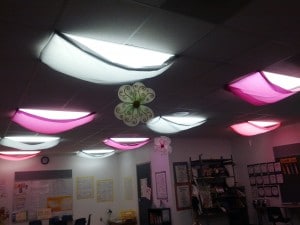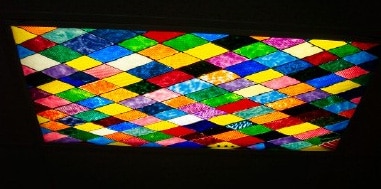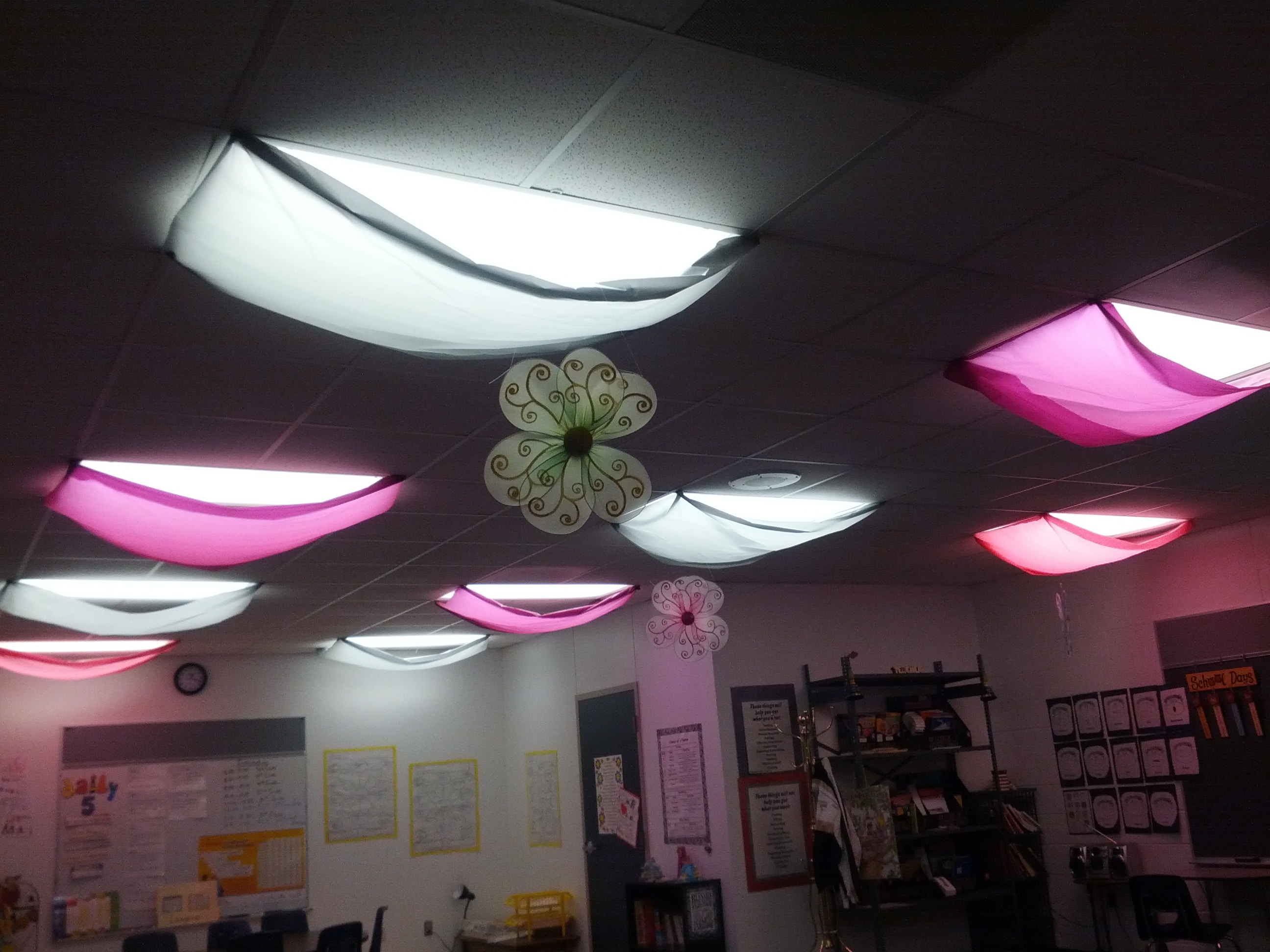The fluorescent lighting used in most classrooms can lead to a host of difficulties for children (and adults), including migraines. By diffusing these harsh lights, and introducing more natural light into the classroom, we’re working with the body’s natural circadian rhythms to indicate to the brain that it’s time to be awake and alert.
While consulting at North Elementary school in Lamesa, TX, I happened to notice that one classroom had a pink and white cloth hanging from the lights. I thought, “Finally, I get to SEE it in a classroom again!” I’ve been telling audiences about this strategy – how to use colored lighting to enhance learning – for years; though usually by using blue fire retardant cloth.
 Colleagues call her classroom “The Victoria’s Secret Room” because of the pink and white color of the drapes.
Colleagues call her classroom “The Victoria’s Secret Room” because of the pink and white color of the drapes.
At another school, in New Hampshire, I discovered one particular classroom with an incredibly calming environment. I immediately noticed that the teacher had turned off the fluorescent lights. Instead, she had four floor lamps and a table lamp strategically placed around the room. There were no cords visible; she had the cords tucked away so that students would not trip on them. She also had calming classical music playing in the background. The difference between that classroom and the hall was striking. Students were on task and happily going about their work.
 Much of the current classroom lighting research centers around the use of blue lighting, but it doesn’t have to be just blue. I remember one classroom in Utah that used blue drapes of different shades over the windows to diffuse the natural light, but another teacher used heat tolerant paints to transform the florescent fixture covers into the works of art you see pictured here.
Much of the current classroom lighting research centers around the use of blue lighting, but it doesn’t have to be just blue. I remember one classroom in Utah that used blue drapes of different shades over the windows to diffuse the natural light, but another teacher used heat tolerant paints to transform the florescent fixture covers into the works of art you see pictured here.
It’s important to follow your school’s rules for such things, but there are a number of things that you can do to make the lighting in your classroom more conducive to learning:
- Replace fluorescent lighting bulbs with full-spectrum bulbs
- Use lamps in the classroom with full-spectrum light bulbs
- Cover fluorescents with curtains made from pajamas made from fire-retardant material
- If your classroom has drop ceilings, cover the clear panels under the fluorescents with heat-resistant blue spray paint (Of course, you will need to discuss this with your school’s administration before painting school property!)
- Put blue fluorescent light protectors over fluorescent bulbs
It’s wonderful to see strategies that I advocate in actual practice. One of the first dimensions of learning is “Attitude and Perception.” The classroom environment plays a key role in promoting positive attitudes and perceptions for learning. Studies have also theorized that natural lighting improves visibility, health, mood, and behavior. And students aren’t the only ones who benefit – adults in the classroom enjoy the benefits of natural lighting as well!
There is actually quite a bit of research now on this issue, including:
Group, H. M., Nc, I., & Cooper, B. K. J. (2008). HMG:: Current Projects:: Daylighting Studies Publicity Page 1 of 5 Study Says Natural Classroom Lighting Can Aid Achievement HMG:: Current Projects:: Daylighting Studies Publicity Page 2 of 5, 1–5.
Cooper, K. J. (1999, November 26). Study Says Natural Classroom Lighting Can Aid Achievement. The Washington Post.
Sleep, S. (2008). Blue Lighting Up The Human Brain At Work, (11), 2007–2008.
Robert, T., & Expert, L. (2008). Lighting as a Migraine Trigger: Fluorescent Lights Migraines at Work? Check the Lighting. Lighting as a Migraine Trigger : Fluorescent Lights, 5–6.
Brigham And Women’s Hospital – Press Releases. (n.d.). Retrieved November 13, 2012, from http://www.brighamandwomens.org/about_bwh/publicaffairs/news/pressreleases/PressRelease.aspx?sub=0&PageID=171
Norris, S. (2016). Fluorescent Lights, Mercury Poses Dim Threat, 2007–2009.
Loisos, G. (1999). Daylighting in Schools. Submitted to George Loisos The Pacific Gas and Electric Company on Behalf of the California Board for Energy Efficiency Third Party Program, 1999(1), 140.
Vandewalle, G., Schwartz, S., Grandjean, D., Wuillaume, C., Balteau, E., Degueldre, C., … Maquet, P. (2010). Spectral quality of light modulates emotional brain responses in humans. Proceedings of the National Academy of Sciences of the United States of America, 107(45), 19549–54. http://doi.org/10.1073/pnas.1010180107
Creek, A. (1998). Case Study: Ash Creek Intermediate School New Ash Creek school gets the most value for funds spent.
Design, S., & Performance, S. (2008). Sustainable Design for Schools Sustainable Design and Student Performance, 1–8.
Raloff, J. (2008). Light Impacts Hue and timing determine whether rays are beneficial or detrimental, 1–10.
I highly recommend that you consider ways to make the lighting in your classroom better for learning so that you can make an even bigger difference for your kids!
*Some parts of this article are excerpted from Paraprofessionals and Teachers Working Together by Susan Gingras Fitzell.

Bring Susan to your campus!
Featured seminar – Paraprofessionals And Teachers Working Together in the General Classroom

